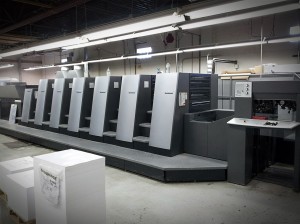Print: it’s not dead yet!
“If journalists are gloomy about the outlook of their industry, printers are despondent.”
That was a 2013 keynote speaker’s headline for his topic, “The Future of Printers.” Subtitle? “Printers Sink.”

Offset press
In the U.S. in 2001 there were 50,000 traditional commercial printing companies (not including phone book and newspaper and magazine publishers). Today there are fewer than 20,000, and those that are still in business find their 1Q13 revenues down 25–50% from a year ago. The environment is brutal. Half the printers I used to work with are no longer in business — and I’m paying a lot less for the same kind of job to those that still are.
Printer-from-birth Chuck Paski at McClafferty Printing says printing “is a tough racket to be in. It’s a commodity now instead of a craft. The buyers know they can beat you up on price, and they’ll take their business down the street to save $10.” Paski has a state-of-the-art six-color press, but only four-color jobs are selling — whatever buyers can get for the cheapest price in the fastest time. McClafferty just added mailhouse services to its portfolio, so it can be a one-stop shop.
Some printers have been able to stay in business by finding a niche. Another one of AB&C’s printers, Mercantile Press, has been in business since 1884 and found that traditional printing work such as financial documents, corporate materials and political direct mail had dried up due to the Internet and high postal costs. Mercantile might not be around today had it not identified an in-demand printing specialty: short-run labels for the chemical and pharmaceutical industries.

Digital press
Digital printing is the only segment of the printing industry showing any growth. Every commercial printer now has at least one digital press on the floor. Digitally printed pieces are customer-cost-effective at very low quantities and can be personalized using a pURL or QR code, and are also suitable for web-to-print applications. However, the printing company does not make the same profit it did on the long-run, offset jobs.
I’ll close with one hopeful insight from a paper industry executive: “Print will never go away completely because it can now be used for what it does best — it is tactile, emotional, engaging, personal and real.” While print is certainly not the only channel of communication, it can still make a powerful statement and is an integral part of today’s media mix — and hopefully will be for a long time.




